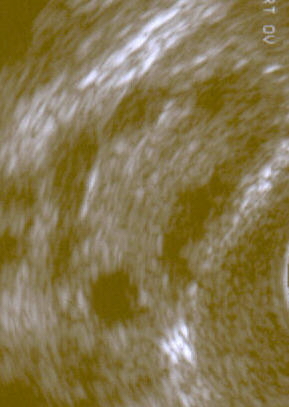Did you know?
You can double click on a word to look it up on TermGallery.
You can double click on a word to look it up on TermGallery.
Meanings of hyperandrogenemia in английском
русский
синдром поликистозных яичников португальский
síndrome de stein-leventhal испанский
sindrome del ovario poliquístico каталонский
síndrome de stein-leventhal 
Set of symptoms caused by elevated androgens in females.
Synonyms
Examples for "pcos"
Examples for "pcos"
1
Conclusions: We identified metabolites that might have causal effects on PCOS development.
2
Environmental factors are thought to be involved in the development of PCOS.
3
Cardiovascular abnormalities represent important long-term sequelae of PCOS that need further investigations.
4
Based on the combination of PCOS symptoms, women formed seven outcome groups.
5
The present study aimed to explore the potential environmental risk factors of PCOS.
1
No diagnoses of endometriosis or polycystic ovaries, nothing like that?
2
Although 82% of women with recurrent early loss have polycystic ovaries on ultrasound imaging, random serum LH concentrations are normal.
3
Twenty-one women with recurrent early pregnancy loss and 10 multiparous controls were investigated; 81% of them and one of ten control subjects had polycystic ovaries.
1
Obesity in polycystic ovary syndrome aggravates the underlying predisposition towards insulin resistance.
2
Obesity increases the severity of the phenotype in women with polycystic ovary syndrome.
3
Only women with known primary infertility or severe polycystic ovary syndrome showed inadequate pregnancy rate.
4
Flutamide plus the oral contraceptive pill is beneficial for acne associated with polycystic ovary syndrome.
5
The majority of these women have polycystic ovary syndrome.
1
Obesity in polycystic ovary syndrome aggravates the underlying predisposition towards insulin resistance.
2
Obesity increases the severity of the phenotype in women with polycystic ovary syndrome.
3
Only women with known primary infertility or severe polycystic ovary syndrome showed inadequate pregnancy rate.
4
Flutamide plus the oral contraceptive pill is beneficial for acne associated with polycystic ovary syndrome.
5
The majority of these women have polycystic ovary syndrome.
Usage of hyperandrogenemia in английском
1
In addition, 24% of the sisters had hyperandrogenemia and regular menstrual cycles.
2
This familial aggregation of hyperandrogenemia in PCOS kindreds suggests that it is a genetic trait.
3
Its association with indices of insulin resistance and hyperandrogenemia is also seen in the same group.
4
We propose that hyperandrogenemia be used to assign affected status in linkage studies designed to identify PCOS genes.
5
Conclusions: Adult female acne may be triggered by diet, stress, and cosmetics and there is a distinct hormonal milieu that accounts for hyperandrogenemia.
6
Other than failure to demonstrate laboratory evidence of hyperandrogenemia, the most common reasons for subject exclusion were persistent oligospermia and tubal factor infertility.
7
The sisters were compared with 70 healthy age- and weight-comparable control women with regular menses, no clinical evidence of hyperandrogenemia, and normal glucose tolerance.
8
Recent data have disclosed a high prevalence of hyperandrogenemia among peripubertal adolescents with obesity, suggesting that such girls are indeed at risk for developing PCOS.
Frequent collocations
Translations for hyperandrogenemia
русский
португальский
испанский
Hyperandrogenemia through the time

